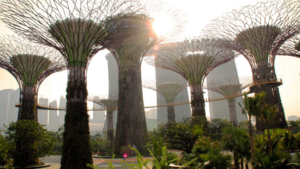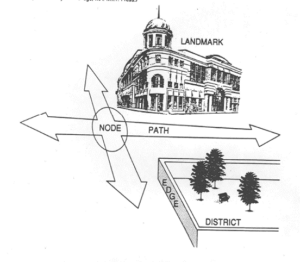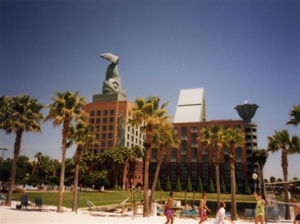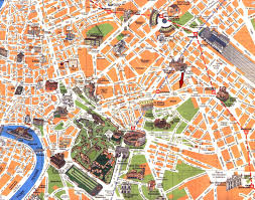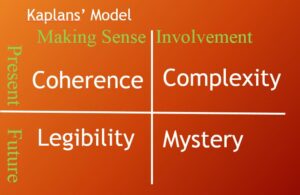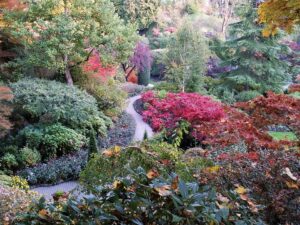Introduction to Environmental Psychology (video)
Psychology and Stuff Podcast: Environmental Psychology
Environmental Psychology at UW-Green Bay
UW-Green Bay Environmental Psychologists
 Dr. Georjeanna Wilson-Doenges
Dr. Georjeanna Wilson-Doenges
Dr. Wilson-Doenges’ research interests involve individual’s interpretation of sense of community and how neighborhood design can foster or break down that sense of community in residential life.
Biophilia and the Promotion of Pro-Environmental Behaviors
The biophilia hypothesis suggests that humans possess an innate tendency to seek connections with nature and other forms of life. In his seminal book, Biophilia (1984) Edward O. Wilson introduced and popularized the hypothesis saying that we, as humans, all possess “the urge to affiliate with other forms of life.”
This hypothesis has become a movement, of sorts, especially within the field of urban design and the creation of biophilic cities with a growing network of cities classified as biophilic. See http://biophiliccites.org/ For example: this downtown park in Shanghai is attempting to create an ecosytem in the center city.
There are many reasons that creating environments that are biophilic will influence people’s desire to be more environmental. Psychologists have been heavily involved in developing ways to change people’s behaviors to be more pro-environmental. These strategies include:
- Antecedent Strategies: Strategies that stop or encourage pro-environmental behavior before it happens.
- Technological Strategies: Strategies that use technological advances to make our choices more environmental and not cost-prohibitive. For example: packaging that reduces waste without us even realizing we are being more environmental is a great way to work toward a healthier environment!
 Photo: http://sungistics.com/
Photo: http://sungistics.com/ - Fun Strategies: Making pro-environmental choices fun can encourage them to happen!


Cognitive Mapping – Wayfinding through our World
Kevin Lynch, in his seminal book, The Image of the City (1960), reported that people could mentally map and understand their environments in very predictable ways. He found that mental maps (maps sketched by a average person from memory) had five common elements:
- paths, streets, sidewalks, trails, and other channels in which people travel;
- edges, perceived boundaries such as walls, buildings, and shorelines;
- districts, relatively large sections of the city distinguished by some identity or character;
- nodes, focal points or intersections;
- landmarks, readily identifiable objects which serve as external reference points.
Photo: www.groups.isschool.berkeley.edu
Lynch also coined the term “wayfinding” to be the psychological way we discover how to make our way through environments. Wayfinding can be promoted by characteristics of the environment including:
- Visual Access: being able to visually see your destination makes it easier to wayfind to that location.
- Degree of Differentiation: having unique qualities throughout the environment that distinguish one street or building from another makes it easier to wayfind through that environment.
- Legibility: being able to make sense of the environment and “read” the travel routes that you would go to get to your destination makes it easier to wayfind to that location.
Why do we prefer one environment over another? The case of the Country Mouse and the City Mouse
A familiar children’s story told by many authors including Walt Disney, titled “Country Mouse, City Mouse” shows that the main characters in the story have different prefences for the type of environment they would like to live in. The City Mouse, of course, preferring the hustle and bustle of the city while the Country Mouse preferring a much simpler and quieter life. This tale illustrates a common concept of Environmental Psychology called environmental preference. Environmental Psychology research shows that we prefer to live in places that are a) at an optimal level of stimulation and arousal for us, b) provide us both prospect and refuge, and c) allow us to make sense of the environment while simultaneously engaging us.

Optimal Arousal in Environmental Preference
Each of us has a different perspective on how much stimulation we prefer: some of us are thrill seekers who love roller coasters and other high speed adventures, who others are more content with slower paced environments. Finding a place where we live, work, and play that provides us the “just-right” amount of stimulation will likely be an environment that we prefer. Oftentimes these environments provide us “affordances” that meet our needs, whether they be a “need for speed” or not!
Which classroom environment seems more of a good fit for your preferred level of stimluation?


Photo: www.itssnc.edu www.kindercraze.com
Prospect-Refuge Theory (Nassar & Fisher, 1992)
Another theory of Environmental Psychology tells us that we prefer environments that have a good deal of both prospect (the ability to see and take in our surroundings) and refuge (places to hide if there is danger). Evolutionary Psychologists believe that we developed this preference as a mechanism for protection from harm in our home environments — where we can see danger coming from afar and hide from it if necessary.

www.designingthelandscape.files.wordpress/
For example, this environment has great prospect over the lawn and some nice refuge from the elements under the protective awning above.
Kaplans’ Model of Environmental Preference
Rachel and Stephen Kaplan (1982) formed a model to describe how environmental preference is based on a good balance between our ability to make sense of the environment and find our way through it and our engagement with that same environment. We prefer environments that make good sense to us, that are legible and coherent – but not to the extreme or else they become boring. The other side of that coin is that we also prefer environments that involve and engage us – want to encourage us to explore by providing good complexity and some mystery – but again, not to the extreme or else they can become scary or overwhelming.
For example: this environment has a path that helps us understand how we would travel through the environment because it is legible. However, there is also a good bit of complexity with the different foliage colors and textures adding engagement and mystery. This environment seems to have a good balance of both “making sense” and “involvement” that would lead us to prefer this place.
Kaplan, R., & Kaplan, S. (1982). Humanscape: Environments for People. Ann Arbor, Michigan: Ulrich’s Books.
Personal Space – How Close Is Too Close?
When it comes to space, there are terms such as personal bubble which individuals use to describe their ideal amount of space away from others. Personal space is the portable and invisible boundary which surrounds your body and it never goes away. Your personal space is always with you.
Some functions of personal space include:
- Avoiding overstimulation
- Avoiding stress
- Avoiding behavior constraint
- Non-verbal communication
- Boundary regulation
- Intimacy-equilibrium model
- Protection from harm
How close is too close? Well, according to Hall’s Spatial Zones, there are levels of appropriate space depending on the relationship between individuals. There are four levels: public space, social space, personal space, and intimate space. The closer the relationship, the less of a distance is allowed between individuals.
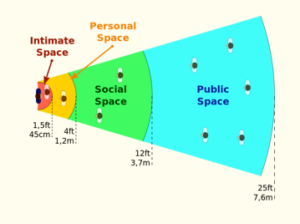
Other factors such as attraction and type of interaction, positive or negative, impact the distance between individuals. Gender, age, and personality traits also play a role in the optimal distance of personal space. When it comes to physical reasons for personal space, individuals require a larger personal space when there is no easy escape route. This is a protective mechanism
When it comes to physical reasons for personal space, individuals require a larger personal space when there is no easy escape route. This is a protective mechanism. When personal space is invaded it results in arousal. When the invasion is unwanted, it results in a flight or fight response.
Watch this video to see people’s reactions to someone “invading” their personal space.
Affordances
Affordances are one of the theories of perception in Environmental Psychology. According to Gibson, affordances are how we perceive environments as ways to afford us our needs.
There are things in the environment which allow us to meet our needs. These needs can be anything from the shade, food, parking, safe walking, sitting, activities, etc. When an environment meets almost all of an individual’s needs, it is an ecological niche. This would be the environment which is most optimal for that individual.
According to Mariela Alfonzo’s 2005 study, individuals base their decision to walk on environmental factors and how those factors fit their desired affordances. The hierarchy of needs for walking begins with feasibility, accessibility, safety, comfort, and finally pleasurability. Like in Maslow’s hierarchy of needs, if the first need is not met, then an individual does not proceed to the next level.
If an environment does not provide or afford, the necessary items then individuals are less likely to interact with the environment. It is important when designing spaces to consider a variety of affordances so the environment can appeal to a variety of optimal levels of affordances.
Watch this video on affordances to learn more!
Alfonzo, M.A. (2005). To walk or not to walk? The hierarchy of walking needs. Environment and Behavior, 37, 808-836. DOI: 10.1177/0013916504274016
Nature is Restorative: The Attention Restoration Theory

Spending time in nature has a large amount of benefits for you. Studies have shown that spending time in nature can provide individuals with renewal cognitive, psychological, and physiological resources. Many people in the world spend a lot of their time inside, either working or relaxing. However, this can lead to increased stress and irritability, while concentration can decrease. This, of course, if not the best way to work and be productive. When we spend time outside, nature can naturally restore us by holding our attention in an effortless way.
Nature can also decrease our stress levels. One study done shows that when individuals were put into stressful situations, and afterwards asked to either walk in the city or walk in nature for 30 minutes. Before they left, participants had their blood pressure and cortical levels measured. Participants who walked in nature for 30 minutes had lower cortical levels and lower blood pressure, which us that their stress had decreased. However, participants who were asked to walk in the city for 30 minutes had no decrease in their blood pressure or cortical levels.
So, when you are feeling stressed, take a walk outside and enjoy the nature surrounding you! If you can’t, research also shows that just looking at nature is restorative! In the meantime, gaze at these beautiful photos of nature and take a deep breath.





